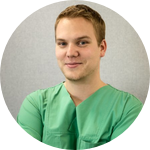About This Project
Ask the Scientists
Join The DiscussionWhat is the context of this research?
The challenge of brain tumor resection is the maximal extraction of tumor tissue while a minimum amount of surrounding healthy tissue is affected. The ultimate goal of this project is to provide surgeons with reliable information about the brain anatomy and tumor location at every single phase of the surgery. This is to be done via matching of the preoperatively acquired Magnetic Resonance (MR) scan and the intra-operatively captured Ultrasound (US) image. However, their image information is not at all related, as MR measures the relaxation times of hydrogen and ultrasound basically visualizes the acoustic properties of tissue. This is a crucial pitfall when attempting to compare these images in order to create an optimal overlay.
Recent publications show promising results by directly correlating MR and US images based on visible anatomical structures. However, once a part of brain tumor tissue is removed, such a correlation is no longer possible. Also, due to surgical interaction with the patient's head, the brain moves during the surgery (brain shift) and a multimodal (MR and US) overlay is hardly possible.
Therefore, we propose to predict the US image from MR data reducing the multimodal matching to a monomodal overlay, which is well researched and established. We will develop a system that employs machine learning techniques to calculate the US impedance signal from an MR scan.
What is the significance of this project?
As surgeries become more and more minimally invasive, surgeons heavily rely on patient image information. The intelligent fusion of preoperative data such as 3D image scans and intra-operative images such as US is the crucial foundation of image guided surgery (IGS) systems. The shift of brain tissue during brain tumor resection is still an unresolved problem and prevents conventional IGS systems to be fully used within clinical environments. A prediction of US images from MR allows the fusion of both image data during surgery in real-time. This allows a surgeon to estimate the true brain-shift, which allows a higher reliability during the resection of tumors or other lesions.
Our research group holds high experience in the design and development of image guided surgery solutions. The big advantage here is our close cooperation with medical partners allowing us to integrate surgeons into the design and development process and making early clinical evaluations and phantom experiments possible. This is the reason why already a few of our previous inventions have made their way into the OR.
What are the goals of the project?
The funds requested will enable students (PhD or Master) to research the relation between Ultrasound and Magnetic Resonance Images and design and develop a complete framework for intra-operative matching of these images. The university and the affiliated hospital will provide lab space, access to imaging (US and MR) devices, clinical support with phantom experiments, while travel costs, living subsidies, and phantoms need to be paid for.
The project is structured as follows:
WP 1 Correlation of US impedance and MR images
WP 2 Real-time matching of US and MR image data
WP 3 Development of early prototype for experiments
WP 4 Phantom experiments
Budget
The requested funds will allow us to support student assistants during their research. A multimodal phantom for US and MRI needs to be acquired.
Meet the Team
Affiliates
Hospital Rechts der Isar, Munich, Germany
Team Bio
The research objective of our group is to study and model medical procedures and introduce advanced computer integrated solutions to improve their quality, efficiency, and safety. We aim at improvements in medical technology for diagnosis and therapeutic procedures requiring partnership between: - Physicians/surgeons - Computer/Engineering scientists - Providers of Medical Solutions The group forms such research triangles and actively participates in the existing ones. The chair aims at providing creative physicians with the technology and partnership, which allow them to introduce new diagnosis, therapy and surgical techniques taking full advantage of advanced computer technology. Visit us at campar.in.tum.deAmit Shah, Bernhard Fuerst, Christoph Hennersperger and Nassir Navab
The research objective of our group is to study and model medical procedures and introduce advanced computer integrated solutions to improve their quality, efficiency, and safety. We aim at improvements in medical technology for diagnosis and therapeutic procedures requiring partnership between: - Physicians/surgeons - Computer/Engineering scientists - Providers of Medical Solutions The group forms such research triangles and actively participates in the existing ones. The chair aims at providing creative physicians with the technology and partnership, which allow them to introduce new diagnosis, therapy and surgical techniques taking full advantage of advanced computer technology. Visit us at campar.in.tum.de
Lab Notes
Nothing posted yet.
Project Backers
- 4Backers
- 3%Funded
- $150Total Donations
- $37.50Average Donation
